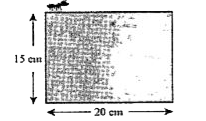An ant is moving on a plane horizontal surface. The number of degrees of freedom of the ant will be
1
2
3
6
The correct Answer is:B
To determine the number of degrees of freedom of an ant moving on a horizontal plane, we can follow these steps:
Step 1: Understand the Concept of Degrees of Freedom
Degrees of freedom refer to the number of independent ways in which a system can move. For a particle in space, this is typically related to the number of dimensions in which it can move.
Step 2: Identify the Movement of the Ant
The ant is moving on a horizontal plane. This means that its movement is restricted to two dimensions: the x-axis and the y-axis.
Step 3: Analyze the Dimensions
- In the x-direction, the ant can move left or right.
- In the y-direction, the ant can move up or down.
Since the ant is constrained to a plane, it does not have any movement in the vertical direction (z-axis).
Step 4: Count the Degrees of Freedom
Given that the ant can move freely in two dimensions (x and y), we can conclude that it has:
- 1 degree of freedom for movement along the x-axis.
- 1 degree of freedom for movement along the y-axis.
Conclusion
Thus, the total number of degrees of freedom for the ant is:
Total Degrees of Freedom=1(x-axis)+1(y-axis)=2
Final Answer
The number of degrees of freedom of the ant is 2.
---
Degrees of freedom refer to the number of independent ways in which a system can move. For a particle in space, this is typically related to the number of dimensions in which it can move.
The ant is moving on a horizontal plane. This means that its movement is restricted to two dimensions: the x-axis and the y-axis.
- In the x-direction, the ant can move left or right.
- In the y-direction, the ant can move up or down.
Given that the ant can move freely in two dimensions (x and y), we can conclude that it has:
- 1 degree of freedom for movement along the x-axis.
- 1 degree of freedom for movement along the y-axis.
Thus, the total number of degrees of freedom for the ant is:
Total Degrees of Freedom=1(x-axis)+1(y-axis)=2
The number of degrees of freedom of the ant is 2.
Topper's Solved these Questions
- KINETIC THEORYBook:AAKASH INSTITUTEChapter:KINETIC THEORYExercise:EXERCISE (ASSIGNMENT) SECTION - B Objective Type Questions
Explore 30 Videos
- KINETIC THEORYBook:AAKASH INSTITUTEChapter:KINETIC THEORYExercise:EXERCISE (ASSIGNMENT) SECTION - C Previous Years Questions
Explore 21 Videos
- KINETIC THEORYBook:AAKASH INSTITUTEChapter:KINETIC THEORYExercise:EXERCISE
Explore 10 Videos
- GRAVITATION Book:AAKASH INSTITUTEChapter:GRAVITATION Exercise:ASSIGNMENT SECTION - D (ASSERTION-REASON TYPE QUESTIONS)
Explore 16 Videos
- LAWS OF MOTIONBook:AAKASH INSTITUTEChapter:LAWS OF MOTIONExercise:Assignment (SECTION-D) (Assertion-Reason Type Questions)
Explore 15 Videos
Similar Questions
Knowledge Check
An ant is moving on a plane horizontal surface. The number of degrees of freedom of the ant will be
A1B2C3D6Study of ants in
AMycologyBMyrmecologyCMalacologyDMyology.Assertion : The number of degrees of freedom of triatomic molecules is 6
Reason : Triatomic molecules have three translational degrees of freedom and three rotational degrees of freedom.AIf both assertion and reason are true and the reason is correct explanation of the assertion.BIf both assertion and reason are true but reason is not the correct explanation of assertion.CIf assertion is true, but the reason is false.DIf assertion is false but the reason is true
A rod or length 2m starts to roll on a horizontal surface as shown in figure. At the same time an ant starts from one end of the rod to other and when the rod rools through a distance 10m the ant dreaches the other end (B). Calcualte the distance and displacement of the ant
(a) with respect to the rod
(b) with respect to the ground.
View SolutionA rod or length 2m starts to roll on a horizontal surface as shown in figure. At the same time an ant starts from one end of the rod to other and when the rod rools through a distance 10m the ant dreaches the other end (B). Calcualte the distance and displacement of the ant
(a) with respect to the rod
(b) with respect to the ground.
View Solutionlong piece of paper is10 cm wide and is moving uniformly along its length with a velocity of 2cm/s. An ant starts moving on the paper from point A and moves uniformly with respect to the paper. A spider was located exactly opposite to the ant just outside the paper at point B at the instant the ant started to move on the paper. The spider, without moving itself, was able to grab the ant 5 second after it (the ant) started to move. Find the speed of ant relative to the paper.

View SolutionThe home of white ant is known as
View SolutionAn ant is sitting at the edge of a rotating disc. If the ant reaches the other end, after moving along the diameter, the angular velocity of the disc will:-
View Solution
